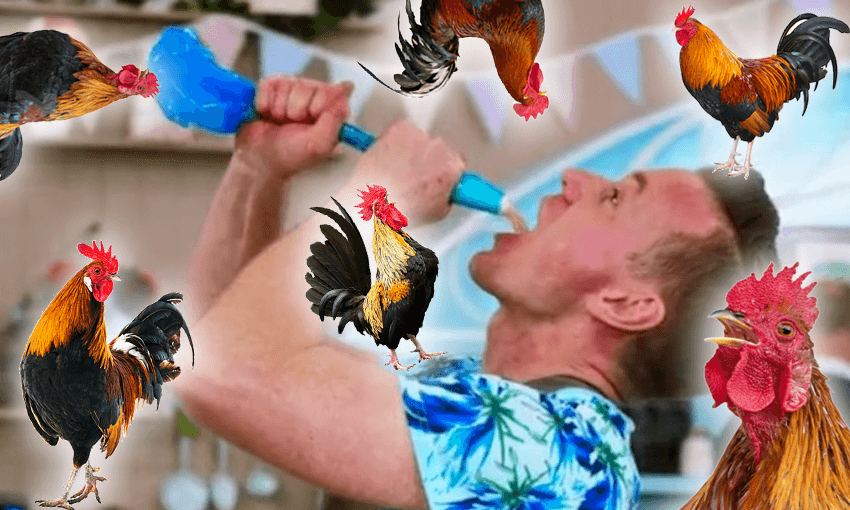This week GKBO showed us what baking heaven really looks like: a cock on a pie. Welcome, ye olde roosters, to Pies and Tarts Week. Tara Ward power-ranks.
Oh GKBO, you spoil us. I thought nothing could reach the giddy heights of last week’s biscuit extravaganza, when we scaled the Eiffel Tower and bathed in the golden rays of a shortbread lighthouse. It seemed only fair that GKBO would peak on that pile of perfectly piped Belgium biscuits, that we had stood at the pearly gates made of gingerbread and sponge nubbins, looked inside, and witnessed paradise.
Our lucky seven bakers first challenge was to whip up a Linzer Torte, a mysterious dish that no-one but Dean and Sue had ever heard of. Turns out it’s a rich dessert with a delicate pastry base, tender jam filling and a spiced melting moment topping. “It’s a fancy berry tart,” said Stacey, which is why she’s won so many challenges. She cuts through the bullshit, chucks a sponge nubbin on top and calls it the Invercargill Water Tower, thank you and good evening.
The pie party continued with the Showstopper Challenge, where bakers created a sweet or savoury family pie with a creative pastry decoration on top. The bakers may have been quiet with concentration, but hosts Madeleine and Hayley were in their best form yet. I’d like to put those two national treasures in a pie, dust them in icing sugar and present them for judging, because they are the tastiest treat GKBO will ever bring to our televisual table.
Let’s gobble down this week’s slice of the GKBO power rankings.
ELMINATED: Clayton
What will we do without Clayton? His elimination is a crime against pies, against television, against pies on television. This is a man who one minute quotes Steve Hansen, the next calls his meat pie ‘One Night in Bangpork’. I mean, we have a winner, New Zealand.
Sadly, Clayton was distracted by Joel’s advice to shut his pie-hole and focus on the baking. “I’d like to stop talking, but does a flamingo forget how to fly?” Clayton said, who spent a lot of time talking about his plan to stop talking. He chatted so much that his pastry didn’t puff and his pork didn’t pull and who knows what the dulce de leche was going on with that checkerboard topping, but it did not end well.
Pie Week was a game, and Clayton was beaten on the puff pastry checkerboard of life. Silent Clayton was a caged beast, a creative genius trapped inside a finely latticed prison of shortcrust pastry. Fly free, you fabulous flamingo.
6) Larissa
Larissa adorned her legendary Tikka Masala pie with the finest pastry rooster you’ll ever lay your eyes on, thus baking her way into New Zealand television history. That cockerel was the double-entendre GKBO’s waited six glorious weeks for, and Larissa served it up on a platter. Who cares that Larissa ended up in the bottom two? With that bird in her corner, she can cock-a-doodle-do this.
5) Jeff
Jeff joked about the “curse of the star baker” but please, Jeff, never joke about pies. A dodgy jam let him down in the Technical Challenge, but hold the phone, stop the bus, take me up la tour Eiffel because look at this golden thing of wonder that Jeff created. This blackberry pie masterpiece saved Jeff’s bacon, it saved his custard, it saved his everything.
4) Joel
After six weeks, the pressure finally got to Joel. He admitted to being in turmoil over whether his pastry would puff, and look how stressed the poor lamb was.
After his “helpful” advice to Clayton, is Joel’s relaxed demeanour just a cunning ruse? He might look like he gives zero forks, but maybe Joel is plotting his way to the final three like he’s a piece of roast kumara on a pastry checkerboard.
It’s a theory that falls over quicker than Sonali’s birdhouse of love, because Joel’s classic Chicken and Leek Pie with the fancy topping impressed the judges no end. If Hannah’s pastry could smell her fear, what did Joel’s pastry smell? Tranquility, probably, with just a whiff of nonchalance. Delicious.
3) Annabel
Sweet pastry angel Annabel. Queen of tarts, dame of the oversized nozzle, legend of the fruity dessert. What more can we say, other than yes please?
2) Stacey
She slayed the Technical Challenge with a torte to end all tortes, and came but a wisp of flaky pastry away from winning Star Baker. It’s not every day you bake something that Dean Brettschneider calls “the bomb”, and our Stacey has her eye on the prize. And the pies. Mmm, pies.
STAR BAKER: Hannah
Victory for soggy bottoms everywhere, after Hannah took out Star Baker with her family fave Chicken, Bacon and Pesto Pie. It was so delicious that the judges lost their ability to form words. “Mmm,” said Dean, and “mmm” said Sue, and honestly, never a truer word has been spoken.



